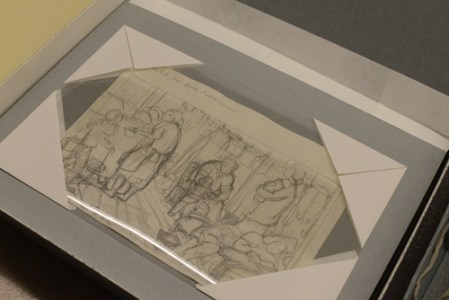JANM’s School Programs Developer Lynn Yamasaki and her family recently had the opportunity to view artworks by her great uncle, Jack Yamasaki, that are part of the museum’s permanent collection.
Jack Yamasaki, my father’s uncle, is someone I only have the faintest memories of seeing on occasion and visiting during holidays. I always knew he was an artist though, because I’ve been surrounded by his artwork my entire life—drawings and paintings by “Uncle Jack” have always hung on the walls of my parents’ and grandmother’s homes. Looking back, his artwork was probably my earliest exposure to art as a child.
A few decades later, I find myself fortunate enough to have studied art and to have worked in museums. I’ve had the opportunity to see some incredible artwork in the various institutions in which I’ve worked, including the Japanese American National Museum, where I currently spend my days. Recently, I had the great privilege of bringing several members of my family to the museum, where staff in the Collections Management and Access (CMA) Unit were kind enough to bring out five works by Uncle Jack for us to look at.
Most of these were pieces that my family and I had never seen before. In some cases, they were gifted to the museum by donors who are not family members. And it was a little odd for me to see Jack Yamasaki’s name among the other great artists in JANM’s collection. Though always appreciated by my family, it wasn’t until recently that I gained respect for the broader significance of his artwork and the events documented in them.

National Museum, Gift of Dr. Kenji Irie.



My family had seen a reproduction of this painting, but it wasn’t until the CMA Unit staff brought it out that we saw the original. We were all struck by how the colors were much brighter than we thought they were. It was the first time my grandma had seen it since Uncle Jack painted it so many years ago.
At first, seeing it again brought up an old annoyance. According to her, she had told Jack she wanted to buy the painting and he said she could. But after one of his exhibitions, she found out that he had sold it to someone else! I remarked that this painting’s journey brought it to JANM, where it is now professionally cared for in a controlled environment. It is probably better off than it would be at her house, and she agreed!


![Estelle Ishigo (Gift of Mary Ruth Blackburn, Japanese American National Museum [2000.103.12])](https://i0.wp.com/media.discovernikkei.org/articles/4279/ishigo2.jpg?resize=269%2C215)